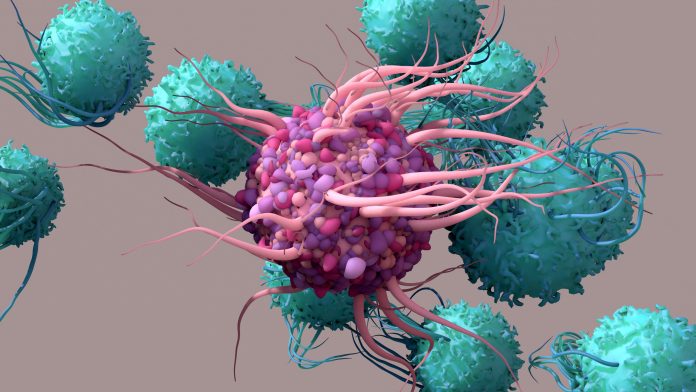
Immunotherapy unleashes the immune system to fight cancer, but it doesn’t work for all patients, and newly reported research may help to explain why. The study, headed by a team at Weill Cornell Medicine, indicates that the genetic program of T lymphocyte immune cells infiltrating malignant tumors, and the developmental path that these T cells then follow, may affect their response to immunotherapy and predict overall patient survival.
The investigators analyzed thousands of human tumor samples, plus individual human T cells across many data sets and tumor types, and compared these to many models of T-cell behavior in response to infections, cancer, and vaccines, including human vaccines. They found that T cells either become stuck in an early activation state or develop into memory cells that are expanded by current immunotherapy approaches.
The study results overturn the prevailing model of immune responses in melanoma and point to the potential for different therapeutic approaches. “The T cells don’t behave in a singular manner, but we can understand their behavior and model it in a way that can predict patient outcomes and overall survival,” said Niroshana Anandasabapathy, MD, PhD, associate professor of dermatology and of dermatology in microbiology and immunology at Weill Cornell Medicine, and a practicing dermatologist for melanoma patients at New York-Presbyterian/Weill Cornell Medical Center. Anandasabapathy is senior author of the team’s study, which is published in Cancer Cell, and titled, “An activation to memory differentiation trajectory of tumor-infiltrating lymphocytes informs metastatic melanoma outcomes.”
Scientists have long known that the immune system can detect and eliminate tumor cells on its own, but this process sometimes breaks down, leading to the development of cancer. Previous data seemed to support a theory in which, once a tumor is established, T lymphocytes entering the tumor keep seeing and responding to tumor proteins until they become exhausted and unable to attack the cancerous cells. That theory was used to explain the success of a type of therapy called immune checkpoint blockade (ICB), which uses cellular signals to improve T cell responses, reawakening the T cells’ ability to attack and eliminate the tumor.
Some patients’ tumors don’t respond to immune checkpoint blockade, though, and the authors noted that there is a need for better classification and insight into these tumor-infiltrating lymphocytes (TILs). “Given that the expression of immune checkpoints is not unique to exhausted T cells and that checkpoint-expressing TILs are not uniformly dysfunctional, the characterization of TILs based on immune checkpoints is likely insufficient to capture TIL status or differentiation,” they wrote. “A more accurate understanding of how human T cells differentiate in the tumor microenvironment (TME) could better inform strategies to sensitize non-responsive patients to ICB, by intervening upon TIL formation and differentiation.”
To help figure out why ICB doesn’t work in some patients, the researchers looked at larger data sets and analyzed them more broadly than in previous studies. “We wanted to take an entirely agnostic approach to trying to understand what happens to a T cell when it enters the tumor microenvironment—a really naive, unbiased approach,” said Anandasabapathy, who is also a member of the Sandra and Edward Meyer Cancer Center and the Englander Institute for Precision Medicine.
“Here, we used an integrated approach to systematically classify both bulk tumors and individual human TILs using stringently defined, large T-cell differentiation state trajectories, and large signatures, derived across many model systems,” they explained. “… we applied advanced functional genomics to interrogate 9,000 human tumors and multiple single-cell sequencing sets using benchmarked T cell states, comprehensive T-cell differentiation trajectories, human and mouse vaccine responses, and other human TILs.”
By using large programs of many genetic markers and multiple, simultaneous genomic strategies to categorize cell fates, Anandasabapathy and her collaborators were able to re-classify T cells in tumors, and better model how they develop. The results showed that infiltrating T cells don’t all meet the same fate in every tumor. In contrast to the standard view, it may be a “failure to launch” beyond early activation and convert to memory, and not exhaustion that appear to be the problem. “Our findings point to a revised model of TIL differentiation, wherein poor outcomes and a lack of ICB responsiveness may represent failed TIL progression from an early activation-like state and/or failed generation of persistent memory,” they wrote. “These data identify an activation-like state associated to poor response and suggest successful memory conversion, above resuscitation of exhaustion, is an under-appreciated aspect of successful anti-tumoral immunity.”
The study found that enrichment of long-lived memory programs correlated strongly with overall survival and a successful response to immune checkpoint blockade therapy in melanoma. “Trajectory analysis of single-cell melanoma CD8+ TILs also identified a high fraction of memory/resident memory-scoring TILs in anti-PD-1 responders, which expanded post-therapy,” they stated. “In contrast, TILs scoring highly for early T cell activation, but not exhaustion, associated with non-response.”
In addition to predicting outcomes, the investigators hope to find ways to change them. Getting T cells past their failure to launch and inducing the formation of tumor-infiltrating memory T cells in patients who lack them, for example, could make non-responsive tumors sensitive to immune checkpoint blockade. “The key distinction of early activation halting from canonical exhaustion suggests that serial therapeutics, which first generate and then promote durable T-cell memory, are likely to complement aPD-1 blockade in melanoma,” the authors stated. “Future work will test variables enabling simultaneous memory conversion and retention in tissue and tumor alike, and model therapeutic drug strategies to promote durable memory phenotypes in these settings.”
While the current work focused on malignant melanoma, the scientists also identified that similar phenomena likely underlie differences in patient T-cell responses to other types of cancer, including kidney, bladder, prostate, and liver cancer.
“The power of the study is really in opening new avenues of discovery and suggesting more rational therapeutics,” said first author Abhinav Jaiswal, a doctoral candidate at Weill Cornell Graduate School of Medical Sciences in Anandasabapathy’s laboratory.”













